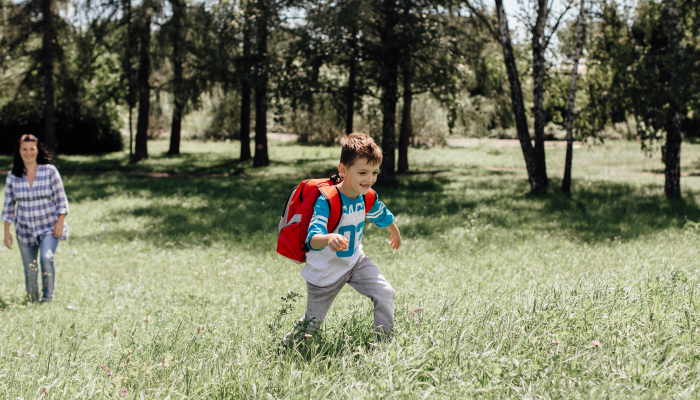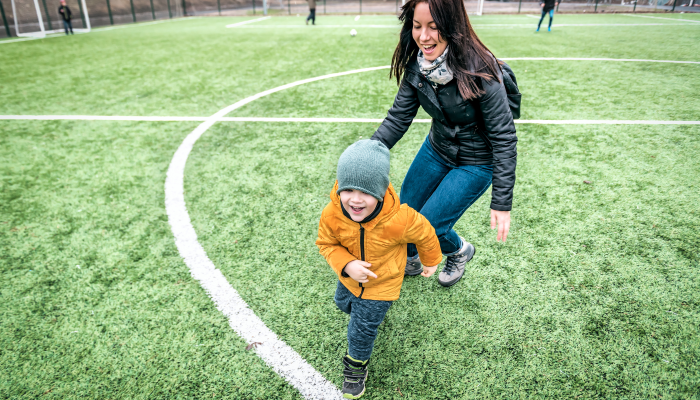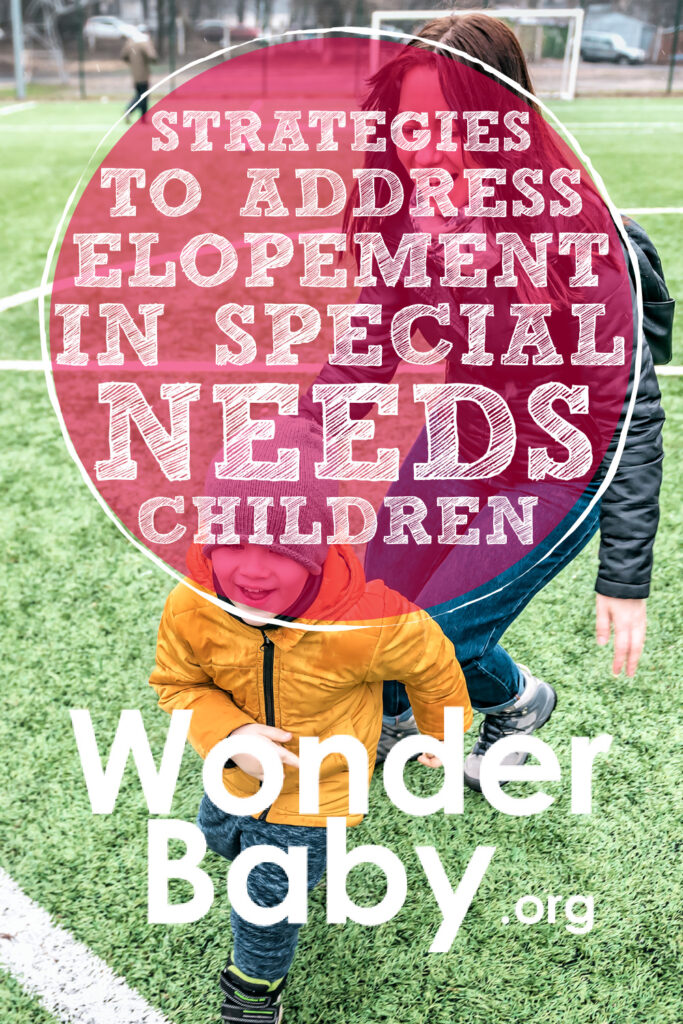7 Strategies to Address Elopement in Special Needs Children

This post may contain affiliate links; please see our terms of use for details.
- Addressing elopement behaviors requires a thorough approach that considers a child’s unique needs, triggers, and challenges.
- Having an elopement plan teaches safety skills and communication strategies to help children express and understand their needs effectively.
- It’s essential to regularly monitor and evaluate interventions to ensure effectiveness and adjust as needed.
There’s nothing scarier than a child running off from their parents or teachers, particularly in a crowded environment. It only takes a few moments for a child to disappear from your view. As an adult, I now understand the fear my mom went through when I was younger and she couldn’t find me in a public place.
It’s common for children with special needs to run or wander from their caregivers or classroom teacher. However, there are ways to plan for and prevent elopement in special needs children.
A behavior plan for elopement, including preventative strategies, can help you and your child in an otherwise stressful situation. While quick answers are great, it’s important to understand the complexity of handling elopement at home, school, or public places.
Understanding Elopement in Special Needs Children

Elopement, or wandering behavior, is a significant concern in special needs children, especially those with developmental disorders.
The Centers for Disease Control and Prevention11. Disability and Safety: Information on Wandering (Elopement). Centers for Disease Control and Prevention. 2019. https://www.cdc.gov/ncbddd/disabilityandsafety/wandering.html (CDC) defines elopement as wandering, leaving a safe area or a responsible caregiver such as a teacher or parent.
The results of a parent survey by the CDC cited the following reasons why children with autism spectrum disorder (ASD) wander off:
- Enjoyment of running or exploring
- Getting out of a stressful situation
- Seeing a desired item
- To participate in a preferred activity
- To get to a place they enjoy (like the playground or pond)
Conducting assessments to understand your child’s triggers and underlying factors leading to elopement is essential. Whether you’re concerned about elopement in the classroom or at home, understanding why it happens can help change the frequency of problem behavior.
Common Characteristics and Patterns of Elopement Behavior

Understanding common characteristics and patterns of elopement behavior can help you and caregivers develop targeted intervention and prevention strategies to address your child’s risk for elopement.
Conditions most associated with elopement include:
- Autism
- ADHD
- Cognitive disorders
- Sensory processing disorders
- Intellectual disorders
Elopement in special needs children stems from various factors, including:
- Difficulty understanding danger
- Sensory sensitivities
- Anxiety
- Communication challenges
- Impulsivity
You may notice decreased elopement behavior when identifying potential triggers and implementing appropriate supports. Understanding how to discipline a child with autism can be tricky for a teacher, but when you understand their triggers, you can better assess their needs.
Warning Signs and Triggers of Elopement Behavior

When you can identify triggers of elopement behavior, you’re better equipped to handle the situation before it happens. Engaging with your child if you see them exhibit any signs of elopement is critical.
You may notice behavioral cues that precede elopement, such as certain sounds or looking for the door. In addition, environmental and social triggers may make your child want to escape without permission.
Common warning signs and triggers of elopement behavior include:
- Boredom or lack of meaningful engagement
- Change in routine or environment
- Physical discomfort or pain
- Specifical environment stimuli (i.e., loud noises, crowds, or unfamiliar settings)
- Restlessness or agitation
- Confusion or disorientation
Understanding autism burnout symptoms can help you determine whether your child is overwhelmed and in need of a change of scenery.
7 Strategies for Preventing Elopement
A solid strategy is vital for preventing elopement to help avoid serious safety risks. Implementing these seven strategies can significantly reduce the risk of elopement while ensuring the safety and well-being of vulnerable individuals.

1. Environmental Safeguards
Implementing environmental modifications to reduce the risk of wandering is a great idea. Alarms, locks, and barriers provide a visual reminder that it’s unsafe to elope from the environment.
Teachers can lock the classroom door and ensure a student’s desk isn’t close to an easy exit. In addition, it’s crucial for teachers to support students with special needs and consider their unique needs when creating a behavioral plan.
If your child is prone to wandering away, it’s a good idea to choose a designated area to meet in a public place. When I’m in a crowded place, I always tell my kids where we should end up if we get separated.
2. Communication and Understanding
If you’re a teacher and a student elopes, it’s important to alert other staff members to ensure the child’s safety. In addition, if your child is under someone else’s care, it’s important to give explicit instructions to them about specific risks of elopement behavior.
You’ll also want to implement clear communication protocols, ensuring everyone knows potential warning signs and triggers. You may consider replacement behavior that offers a better outcome than eloping from their environment.
You can also work on communicating with your child so they feel comfortable notifying you if they feel overwhelmed. If your child is nonverbal, consider devising a sign they can give if they are uncomfortable.
Remember, it will take time for elopement behaviors to improve, so work with your child as they adapt the necessary skills.
3. Behavioral Interventions
If you see the elopement, it’s crucial to intervene quickly so your child doesn’t wander off. You’ll also want to consider replacement behaviors to help your child transition.
Depending on your child’s personality, you may consider individual intervention plans. For example, a child with oppositional defiant disorder will likely exhibit uncooperative behavior while you’re trying to get them to listen.
Remember to encourage and offer your child positive behavior support and reinforcement, ensuring they understand your intentions.
It’s also a great idea to keep track of previous elopement incidents, including triggers, behaviors, and outcomes, to help prepare for and prevent future incidents.
4. Functional Behavior Assessment
A functional behavior assessment helps you create a behavior plan to address specific behaviors.
Here’s an example of a behavior intervention plan for elopement from Pathfinders for Autism22. Frank, L.. PFA Tips: Wandering and elopement at school. Pathfinders for Autism. https://pathfindersforautism.org/articles/safety/elope-at-school:
| Preventative Strategies | Teaching Strategies | Consequences |
| Allow the child to come into homeroom in the morning with nothing on the desk. | Read social stories and discuss school rules. | Remind the child of the school’s safety rules. |
| Read social stories on school safety rules and how staying in the classroom keeps you safe. | Model appropriate responses of replacement behaviors for elopement. | Inform the child of the delay in the earned break until work is finished. |
| Present the child with a choice of tools to practice letters. | Practice using replacement behaviors daily. | Remind the child his parents will be notified if he elopes. |
| Give alerts to the child when tasks are scheduled. | Reward the child immediately when a child acts appropriately to a task. | |
| Offer child choices for ways to complete their tasks. |

5. Structured Routines and Activities
Establishing a structured daily routine and engaging your children in meaningful activities to help reduce restlessness and boredom, common triggers for elopement, are essential.
Consider offering opportunities for social interaction, physical exercise, and cognitive stimulation to promote well-being and engagement.
For example, plan a fun activity daily that considers your child’s behavior and sensory needs, allowing them time to engage in activities that interest them. If that means they run laps until tired, then so be it.
Some students find sitting at a desk all day hard work, so it’s important to keep them engaged and interested in what’s going on in the classroom.
6. Wearable GPS Devices
Elopement is sometimes a flight response for overwhelmed children, so you may consider a GPS device if your child exhibits unpredictable behavior. A GPS device can help track your child if they leave without permission and you want to ensure you find them quickly.
Examples of wearable GPS devices include:
- Keep track of and find your items alongside friends and devices in the Find My app
- Simple one-tap setup instantly connects AirTag with your iPhone or iPad
- Play a sound on the built-in speaker to help find your things, or just ask Siri for help
- Precision Finding with Ultra Wideband technology leads you right to your nearby AirTag (on select iPhone models)
- Apple AirTag (You can put it in a Waterproof AirTag Bracelet for Kids)
- 【Perfectly Fit For AirTag】- Specially designed for Apple Air Tag finder, this bracelet is made of premium soft and flexible silicone with a precise slot that fits your Air Tag without being too loose or too tight. It’s easy to install and detach.
- 【Waterproof Upgrade】- The Air Tag wristband features a full-coverage design that encloses the Air Tag in a round protective lid. This design achieves better water resistance, making it suitable for splashes while playing in the pool or at the beach [Can be used for waterproofing in life, NOT be immersed in water for a long time]. This will keep your Air Tag up and running and looking new.
- 【Improvement Design】- The adjustable Air Tag wrist strap features a specially designed buckle that holds the Air Tag securely on wrist, so you never have to worry about the strap falling off. The full-coverage design won’t affect the Air Tag’s signal, making it an excellent anti-loss GPS tracker hidden accessory. The strap is precisely the right length – not excessively long or short – which makes it highly suitable, especially for kid and toddlers, with a length fits 4.5-7.5″ (115 mm-190 mm)
- 【Multiple Features】- The highly elastic strap has impact resistance, anti-scratch, sweat-proof, anti-fingerprint, breathable, and easy to clean. It enables your child to play without worries in the beach, swimming pool, and children’s playgrounds. You can choose from different colored bands to match your kid’s new dress and enjoy new surprises every day.
- Voice Calls – Xplora XGO 3 is able to make and receive calls from pre-saved numbers
- Messages – The device can receive texts, emojis, images and voice messages and reply with images, emojis and voice messages
- SOS – In an emergency the SOS button can be pressed by the child to notify emergency contacts of their location
- GPS & Safety Zones – Xplora XGO 3 uses multiple services to show the device location. An option is available to setup Safety Zones around key locations such as home and school
- FREE SERVICE FOR 1st MONTH with easy activation | MONTHLY SUBSCRIPTION REQUIRED: 49.99 per month with a 1-year contract & includes SIM card, Unlimited Live Tracking, Assistive Speakerphone with 60 Voice Mins per month, Intelligent Alerts, Premium Safety Features, Unlimited Live US Customer Care, & more | KIT INCLUDES: AngelSense GPS Device with Speakerphone, Soft Protective Sleeve, 3 Non-Removable Fasteners, Parent Key
- PREMIUM ASSISTIVE TECHNOLOGY: Safest solution for autism, special needs & dementia | Offers continuous, all-day, ACCURATE & RELIABLE REAL-TIME TRACKING: Outdoor & Indoor | PROACTIVE ALERTING: Know immediately if your loved one elopes | ASSISTIVE SPEAKERPHONE with AUTO PICKUP: Talk to your child at any time or listen in & make sure they’re ok, Auto-Answer Call: provide them with effective remote support, SOS Call Button | CUSTOMIZABLE: Geofences, Safe Places, Guardians | Detailed Location History
- INTELLIGENT ALERTS: Only AngelSense Auto-Learns daily routine for alerts when potentially dangerous situations occur: Early Departure, Unexpected Places, Late Arrival, Late Departure | SAFE RIDE MONITORING: Live Route, Max Speed, ETA, Unexpected Delays & Stops, Know if they miss the bus, get off at the wrong stop, the bus breaks down, or got off the bus but didn’t go into school. Standard GPS devices only provide alerts for preset geofences, we monitor your loved one anywhere & everywhere!
- EMERGENCY SEARCH TOOLS: Share live location, updated in real-time, via text message to your search team, See where you are in relation to your loved one and get directions | AUDIBLE DEVICE ALARM: Hear where they are if hiding or find them if lost in a crowd | WELL-BEING FEATURES: Step Counter, 1-Way Voice to hear how they are, Location Playback History | SCHOOL DASHBOARD: Customization during school hours, offers limited access for teachers and staff
Consider your child’s privacy when choosing a GPS device, and let them know of your plan. If you don’t want to use a GPS device, consider buying a medical ID bracelet with identification information in case your child gets lost.
- Premium GPS Tracker — The LandAirSea 54 GPS tracker provides accurate global location, real-time alerts, and geofencing. Easily attaches to vehicles, ATVs, golf carts, or other critical assets.
- Track Movements in Real-Time — Track and map (with Google Maps) in real-time on web-based software or our SilverCloud App. Location updates as fast as every 3 seconds with historical playback for up to 1 year.
- Powerful & Discreet — The motion-activated GPS tracker will sleep when not in motion for extended periods, preserving the battery life. The ultra-compact design and internal magnet create the ultimate discreet tracker.
- Lifetime Warranty — This GPS tracker is built to last. LandAirSea, a USA-based company and pioneer in GPS tracking offers a unconditional lifetime warranty that covers any manufacturing defects in the device encountered during normal use.
7. Involve Community and Neighbors
If your child is prone to escape, it’s a great idea to tell your neighbors so they can inform you if they see them out. You may consider setting up a community alert plan to create a network of support and surveillance.
Depending on your neighborhood, you may consider putting up visual aids and signage with information about elopement to increase awareness and guide community members if they encounter a wandering child.
However, it’s important to remember you shouldn’t rely solely on your neighbors regarding your child’s safety. While having fantastic, involved neighbors is ideal, you don’t want to assume they will take control of a situation if your child wanders from home.
FAQs
How can I explain my child’s elopement behaviors to family and friends?
When explaining your child’s elopement tendencies, it’s vital to be straightforward with family and friends. You should also alert them of the best ways to prevent and intervene in elopement while providing a safe environment.
Remember to keep your expectations low, as only some understand the importance of a behavior plan for elopement.
Can therapy help with replacement behavior for elopement in special needs children?
If your child frequently leaves without permission, you may want to consider therapy to help reduce elopement incidents and work on changing inappropriate behavior. In addition, therapy can help address underlying factors contributing to elopement behavior and teach appropriate coping skills.
How can I teach my child with autism about the dangers of elopement?
It can be challenging to teach explicit instruction to a child with autism about the dangers of elopement; however, it can help prevent future safety risks. For example, you may want to teach problem-solving skills so they can better handle uncomfortable situations.
References
- Disability and Safety: Information on Wandering (Elopement). Centers for Disease Control and Prevention. (2019, September 18). https://www.cdc.gov/ncbddd/disabilityandsafety/wandering.html
- Frank, L. (n.d.). PFA Tips: Wandering and elopement at school. Pathfinders for Autism. https://pathfindersforautism.org/articles/safety/elope-at-school

Related Posts

Eye Conditions and Syndromes, Visual Impairment
Neuralink Announces Plans to Restore Sight to the Blind with Brain Chip
Elon Musk’s company Neuralink has announced plans to begin human trials of its new “Blindsight” brain chip by the end of 2025.

Special Needs
5 Spring Cleaning Tips for Families of Children with Disabilities
Spring cleaning is an opportunity to create a more accessible, organized, and supportive space for your child with disabilities. Declutter, deep clean, and refresh!

Visual Impairment
The Gift of Understanding: How a Young Child Helps His Blind Father Navigate Life
When a parent is blind, it’s natural for people to wonder how their sighted child will adapt. Will they struggle to understand their parent’s needs? Will they feel burdened by...




